A Journey to a Better Me 2017
Part 1
City ∗ Building ∗ People
From July 9 to 23, 2017, the “2017 A Journey to a Better Me” delegation of 33 students from the Faculty of Built Environment went on a 14-day academic visit to Japan. During the academic visit, the delegation participated in course learning and academic discussion in related departments and schools of 7 internationally renowned universities, including The Tokyo University, Kyoto University, Hokkaido University, Osaka University, and Waseda University. In this process, they obtained a deeper understanding of how Japan dealt with the relation among the city, buildings and people in urbanization.
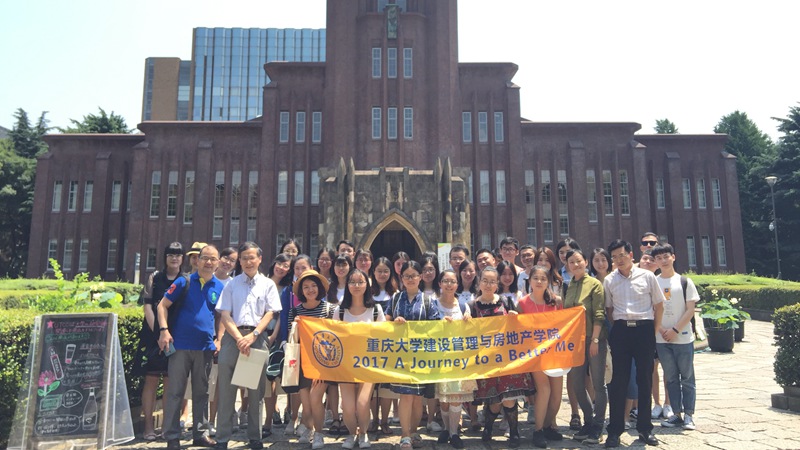
Group Photo
July 11: The Tokyo University
Tokyo University is a world well-known comprehensive university that has a history of 140 years. It is one of the world best universities in terms of research of civil engineering and architecture.
During the academic visit, Professor Sennkenn Yasushi from the Faculty of Engineering introduced the delegation to his recent research achievements: How the land owners should measure the value of their land when it comes to land acquisition in the process of urbanization; the housing vacancy rate in cities and impact of repeated construction on the society and economy of the area. Teachers and students of the delegation were greatly impressed by exquisite publicity material package of Tokyo University, an evidence of the serious, careful and professional altitude towards work of Japanese people.
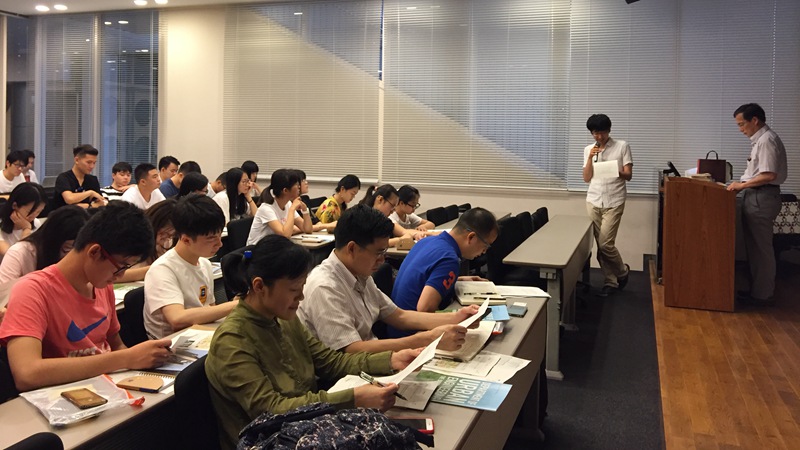
The delegation are listening to the academic report delivered by Professor Sennkenn Yasushi.
July 12: Sophia University
Sophia University, Waseda University and Keio University are the top 3 private universities in Japan. It has a high international standard and holds its unique perspective in the research of cities.
Professor Huang Guangwei from the Institute of Earth environment of Sophia University delivered a marvelous report on urban flood management. Professor Huang pointed out in his report that both urban flood disasters and economic growth accorded with Environmental Kuznets Curve hypothesis. However, the simulation of the economic data and flood disaster data of Chongqing in the past nearly 20 years showed that the flood disaster and economic growth of Chongqing did not completely accord with the Environmental Kuznets Curve. This indicates that there are some problems with the urban construction of Chongqing. On this basis, Professor Huang put forward a new idea to "shift the focus from flood disaster handling to flood management".
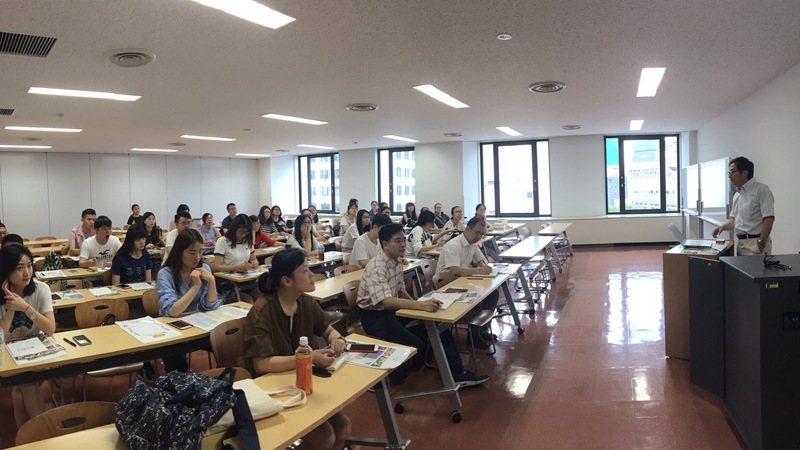
The delegation are listening to the academic report delivered by Professor Huang on urban flood management.
July 13: Waseda University
Waseda University is one of the Asian universities with the highest level of internationalization, and has the most overseas students in Japan.
The application of BIM technology in construction is currently a big hot topic. Professor Kano Shigeo from the Faculty of Architecture of Waseda University gave a warm reception to the delegation. Professor Kano Shigeo went briefly through the application of BIM in the building industry of Japan and emphasized on the modeling based on point and group data. Professor Kano Shigeo also gave some examples to explain the application of model in BIM and its effect.
After that, postgraduate students from the Faculty of Architecture delivered a report on the current situation of the building industry in Japan, and gave a macro view of Japan's building industry.
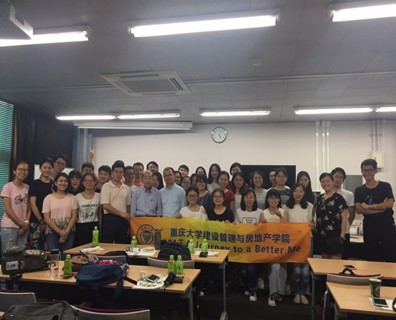
嘉纳成男教授与访学团合影
Photo of Professor Kano Shigeo and the delegation
July 14: Shibaura Institute of Technology
Shibaura Institute of Technology is one of the 4 best private universities of science and engineering in Japan. At Shibaura Institute of Technology, Professor Hitoshi Kuwata introduced the delegation to the history of the reclamation works in Tokyo Bay and the progress of sprawling of residential area in west suburbs of Tokyo. During the Edo period in the 17th Century, Shogun initiated large-scale reclamation in Tokyo Bay. With increase of the urban population, recycling and placement of household waste became the starting point of the reclamation in Tokyo. After the World War II, the reclamation works was gradually restored. A great number of public infrastructures were built at the bay, such as widely known Ginza, Odaiba and Tsukiji. These are all built on the marine reclamation land. By 2020, some stadiums of Tokyo Olympics are expected to be located on the marine reclamation land.
Besides, Profssor Kuwata Nin also pointed out problems with urban development of Tokyo, such as the shortage and deficiency in supporting medical and educational facilities as a result of emerging super high-rise buildings. Professor Kuwata Nin suggested that big cities and megacities learn from the experience of Tokyo in their development, and that the government attach enough importance to reasonable allocation of related resources.
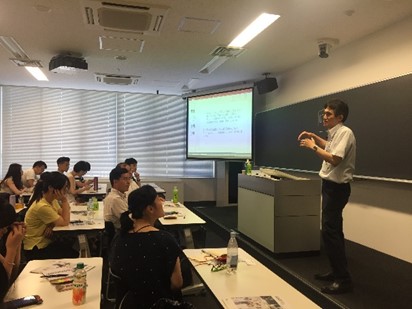
Professor Kuwata Nin from Shibaura Institute of Technology is introducing the reclamation works in Tokyo.
In the afternoon, the delegation arrived at Chiba Campus of Tokyo University to listen to the academic reports delivered by two students majoring in environmental science. Tokyo University has been attaching great importance to interdisciplinary cooperation and research. The delegation were amazed by the international atmosphere the moment they walked into the classroom. Students of different skin colors from different professional backgrounds were all here to listen to the research report delivered by students from another professional backgrounds. After the report, they would ask questions and put forward suggestions, learn from each other and make progress together. The topic of the first student report was influencing factors of heatstroke among senior citizens in Tokyo, which tried to identify the major influencing factors of heatstroke among senior citizens by quantifying factors such as their income level and medical history. The second student shared his personal experience in breeding palola viridis in Samoa where he lived, and his study of the relation between palola viridis and factors such as climate and environment.
July 18: Hokkaido University
]The delegation visited Hokkaido University and had in-depth exchange and discussion with the team of Professor Suguru Mori from the Department of Architectural Urban Space of the School of Engineering. The team of Professor Suguru Mori introduced the delegation to the cultural customs of Hokkaido University and showed them some of the latest research findings of the team. During the discussion, the delegation members were deeply impressed by the practicality and rigorousness of the team in scientific research, and got to know the different education modes adopted by Hokkaido University for undergraduates and postgraduates.
Hokkaido University has been attaching great importance to the cultivation of academic independent and awareness of social participation of its postgraduate students. Japanese students generally earn their living expenses by doing part-time jobs. They participate in various on-campus and off-campus activities such as sports events, campus festival, shrine festival and beer festival. In doing so, their autonomous ability and self-reliance ability get improved and they also get to learn some teamwork skills and social etiquettes.
After the discussion, Professor Suguru Mori showed the delegation around the campus of Hokkaido University. During the visit, the delegation were impressed by the subtle details of the architectural design of the campus, and felt the ingenuity of the designers. For example, the students could see the internal structure of a building through its envelope but the appearance of the building itself is not compromised; a sophisticated supporting system that is used for a small-sized building; the student studio that has a reasonable and effective layout.
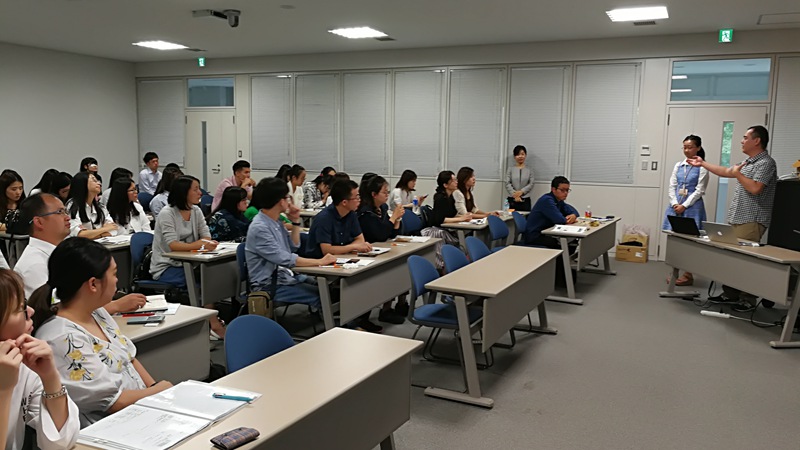
Professor Suguru Mori is introducing its team to the delegation.
July 20: Kyoto University
Professor Takashi Kaneta from the Department of Architecture and Construction Engineering of Kyoto University gave an overview of Kyoto University to the delegation. After that, postgraduate students of Professor Takashi Kaneta's team shared with the delegation their latest research findings.
Professor Furusaka Shuzo delivered a report titled Thoughts on Pile Foundation Problems. Professor Furusaka Shuzo shared with the delegation real cases of houses rendered in great danger as a result of unauthorized alternation of the real estate of Mitsui & Co. According to Professor Furusaka Shuzo, the multi-layer subcontracting system currently being implemented in Japan basically brought an end to professional problems. However, the management becomes more difficult. In bidding, the pre-determined construction schedule might not coincide with the actual construction period of the construction contractor. As a result, the construction quality would be compromised due to working hast to meet the deadline. To this end, he suggested that the bidding and construction information be made public and transparent throughout the process to ensure it is supervised by the public; for supervision and management, third-party supervision should be introduced to reduce potential risk.
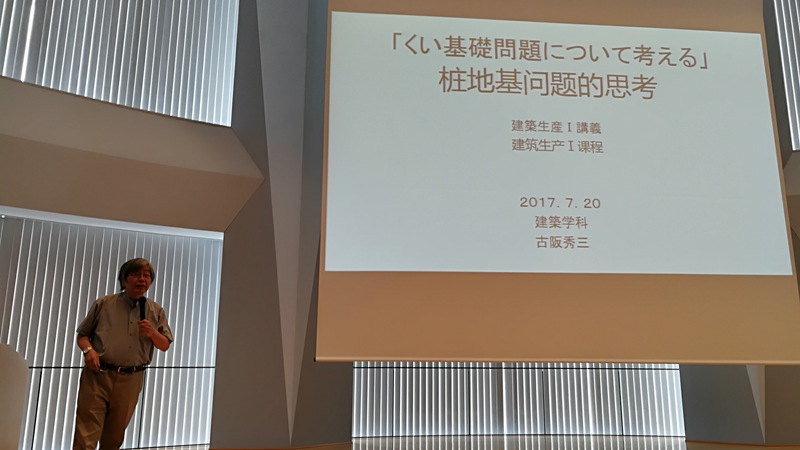
Profssor Furusaka is delivering an academic report for the delegation.
July 21: Osaka University
Sumiyoshi Kenji, head of the International Department of Osaka University extended his warm welcome to the delegation upon its arrival, and gave an overview of the University. After that, Michihiro Kita, a professor in architecture and urban design, delivered a splendid lecture on urban architectural design to the delegation.
Professor Michihiro Kita explained what Urban Morphology is, and expounded on the specific practice of Urban Morphology taking Venice as an example. On the basis of European Urban Morphology, Japan established the spatial anthropology, which has now evolved into urban architecture. Urban architecture advocates consideration of architecture from perspective of a city and studies the types of buildings from the perspective of urban form. This way, traditional and cultural style of a city can be continued while giving rooms for innovation.
Professor Michihiro Kita made comparison between the pictures of Tokyo in the Edo period and in nowadays, showed the 6 development stages of Tokyo during this period and introduced the theory of defensible spaces. Defensible spaces refer to the public spaces, semi-public spaces, semi-private spaces and private spaces as identified by people according to the surroundings. The development and evolution of human dwellings and their need for space were roughly summarized based on this theory. Professor Michihiro Kita recommended some measures such as adoption of land share mechanism, reservation of semi-public spaces for children and senior citizens and development of green and environmental protection organizations. Besides, Professor Michihiro Kita showed the delegation his study of the changes of folk domicile configuration conducted in Zhejiang and other places.
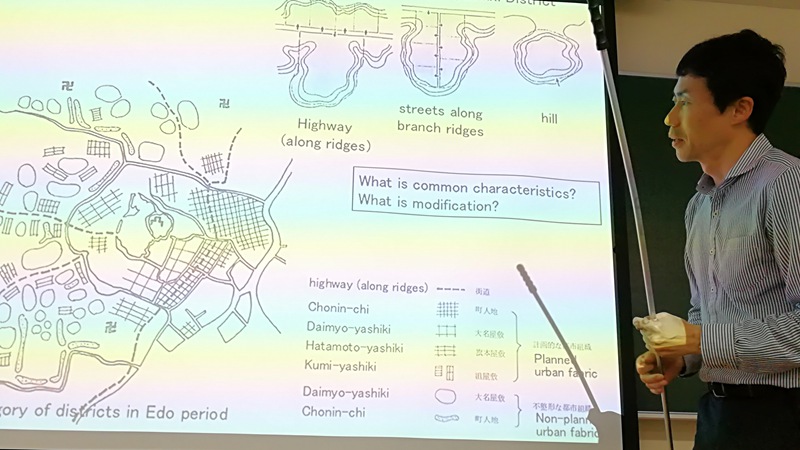
Professor Michihiro Kita is delivering an academic report for the delegation.